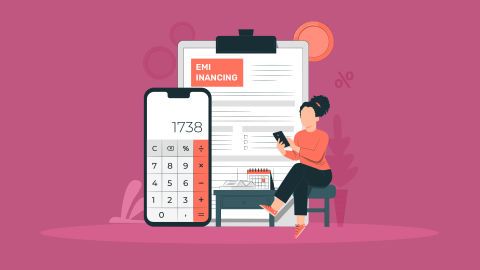With rising prices of kitchen appliances, affording both might stretch your budget. The good news is that with the Bajaj Finserv Insta EMI Card, you can purchase either appliance on Easy EMIs without straining your finances.
Introduction to OTG and microwave
OTG (Oven Toaster Grill) and microwave ovens are must-have kitchen devices in many Indian homes. While both help you cook food, they use different technologies and excel at different cooking tasks. OTGs rely on heating elements that produce dry heat, making them perfect for baking and grilling. Microwaves use electromagnetic waves to heat food quickly, making them ideal for reheating and quick cooking.
What is an OTG (Oven Toaster Grill)?
An OTG is a compact cooking appliance that uses heating elements at the top and bottom to cook food with dry heat. It works much like a traditional oven but in a smaller size. The heating coils warm up and radiate heat throughout the chamber, cooking food from the outside in. OTGs are perfect for baking cakes, cookies, bread, and pastries. They also excel at grilling vegetables and meat to get that perfect charred effect.
What is a microwave oven?
A microwave oven cooks food using microwave radiation, which agitates water molecules inside the food. This creates friction, which produces heat and cooks the food from inside out. Modern microwaves come with additional features like convection and grill functions. The basic microwave model is best for reheating food, defrosting frozen items, and cooking simple dishes quickly. They heat food much faster than OTGs but cannot brown or crisp food surfaces.
Key differences between OTG and microwave
When comparing OTG and microwave ovens, several factors set them apart. Understanding these differences will help you decide which appliance suits your cooking style better.
| Feature | OTG (Oven Toaster Grill) | Microwave |
| Cooking method | Uses heating elements to produce dry heat; cooks food from outside in | Uses electromagnetic waves to agitate water molecules; cooks food from inside out |
| Pre-heating time | Requires 10-15 minutes pre-heating | No pre-heating needed; starts cooking immediately |
| Cooking speed | Slower cooking; allows flavors to develop better | Much faster cooking; ideal for quick meals |
| Energy consumption | 1,200-2,000 watts; higher overall due to longer cooking times | 700-1,300 watts; more energy-efficient due to shorter cooking times |
| Capacity and size | 10-60 litres; takes up more counter space | 15-40 litres; more compact design with typically rounded interior |
| Versatility in cooking | Excels at baking, grilling, toasting, and roasting | Best for reheating, defrosting, and quick cooking |
| Cost and maintenance | Rs. 3,000-15,000+; requires regular cleaning of trays and racks | Rs. 5,000-25,000+; easier to clean with simple wiping |
Cooking method
- OTG: Uses heating elements at the top and bottom to produce dry heat. The heat radiates throughout the chamber and cooks food from the outside in. This method is perfect for baking, roasting, and achieving a crispy texture.
- Microwave: Uses electromagnetic waves that penetrate food and agitate water molecules. This creates friction that produces heat, cooking food from the inside out. This method is ideal for quick heating but cannot brown food surfaces.
- OTG: Requires pre-heating before cooking, which typically takes 10-15 minutes. This is because the heating elements need time to reach the desired temperature. While this adds to the total cooking time, it ensures even cooking results.
- Microwave: Does not require pre-heating and starts cooking immediately. This makes microwaves much faster for quick meals and reheating leftovers. You can simply put your food inside and start cooking right away.
- OTG: Cooks food more slowly as heat needs time to penetrate through the food. A cake might take 30-45 minutes to bake in an OTG. The slower cooking process allows flavours to develop better, making it ideal for recipes that need precision.
- Microwave: Cooks food much faster as the waves directly heat the water molecules inside. The same cake might take just 5-10 minutes in a microwave, though the texture will differ. Microwaves are best when you need quick results.
- OTG: Consumes more electricity, typically between 1,200-2,000 watts. Because cooking times are longer, the overall energy usage is higher. An OTG needs to maintain heat throughout the cooking process, which requires continuous power.
- Microwave: Uses less electricity, usually between 700-1,300 watts. Despite higher wattage ratings in some models, the shorter cooking times mean that microwaves are more energy-efficient overall. They only need to run for a fraction of the time an OTG requires.
- OTG: Available in various sizes from 10 to 60 litres. Larger models can accommodate multiple dishes at once, making them suitable for baking multiple items. They take up more counter space due to their box-like structure.
- Microwave: Typically range from 15 to 40 litres. They have a more compact design that fits easily on countertops. The interior space is usually round, which can limit the shapes of containers you can use.
- OTG: Excels at baking, grilling, toasting, and roasting. You can make cakes, cookies, bread, pizza, grilled vegetables, and roasted meat. It provides better texture and browning for various foods. Many bakers prefer OTGs for their consistent results.
- Microwave: Best for reheating, defrosting, and quick cooking. Basic models cannot brown or crisp food, though convection microwaves add this capability. They're excellent for heating liquids, making popcorn, and steaming vegetables.
- OTG: Generally more affordable, with prices starting from Rs. 3,000 to Rs. 15,000+ for high-end models. Requires regular cleaning of trays, racks, and the interior to remove food particles and grease. The heating elements may need replacement after years of use.
- Microwave: Usually costs between Rs. 5,000 to Rs. 25,000 or more, depending on features. Easier to clean as food rarely sticks to the walls. Simply wiping the interior with a damp cloth is often sufficient. They typically have a longer lifespan with fewer maintenance issues.
Understanding the advantages and limitations of both appliances will help you make a better decision based on your cooking needs.
| Appliance | Pros | Cons |
| OTG | Excellent for baking cakes, cookies, bread Better browning and crisping for foods More affordable than convection microwaves No radiation concerns | Longer cooking times due to pre-heating Higher electricity consumption Takes up more counter space Inefficient for reheating and defrosting |
| Microwave | Cooks food very quickly Excellent for reheating without drying out food More energy-efficient overall Defrosts frozen food quickly and evenly | Cannot brown or crisp food surfaces Not ideal for traditional baking More expensive than basic OTGs Round turntable limits container sizes and shapes |
Pros and cons of OTG
Pros:
- Produces excellent results for baking cakes, cookies, bread, and pastries. The dry heat circulation creates the perfect environment for baking.
- Provides better browning and crisping for foods like pizza, toast, and grilled items. You can achieve that golden-brown finish that microwaves cannot provide.
- More affordable than convection microwaves. You get better baking capabilities at a lower price point.
- No radiation concerns that some people have with microwaves. The cooking method is similar to traditional ovens.
- Requires longer cooking times due to pre-heating and slower heat penetration. You need to plan ahead when using an OTG.
- Consumes more electricity because of longer operation times. This might affect your electricity bills if you use it frequently.
- Takes up more counter space due to its boxy design. You need adequate kitchen space to accommodate an OTG.
- Not efficient for reheating food or defrosting frozen items. These tasks take much longer in an OTG.
Pros:
- Cooks food very quickly, saving valuable time in busy households. You can have meals ready in minutes.
- Excellent for reheating leftovers without drying them out. The food retains moisture better than when reheated in an OTG.
- More energy-efficient due to shorter cooking times. Despite higher wattage, the overall energy consumption is lower.
- Defrosts frozen food quickly and evenly. This is one of the biggest advantages over OTGs.
- Basic models cannot brown or crisp food surfaces. Foods like pizza or toast will not have the same crispy texture.
- Not ideal for traditional baking as it cannot provide the dry, consistent heat needed. Cakes and cookies may have different textures.
- More expensive than basic OTGs, especially convection models with additional features. The initial investment is higher.
- The round turntable limits the size and shape of containers you can use. Square or rectangular dishes might not fit or rotate properly.
The choice between an OTG and microwave depends on your cooking preferences and lifestyle. If you enjoy baking cakes, cookies, and bread, or if you frequently grill or roast food, an OTG would serve you better. The dry heat circulation creates the perfect environment for these cooking methods.
If your priority is quick reheating, defrosting, and simple cooking, a microwave would be more suitable. For those who want the best of both worlds, consider a convection microwave that combines microwave technology with convection heating.
Check your eligibility for a Bajaj Finserv Insta EMI Card to make your purchase more affordable. You may already be eligible - find out by entering your mobile number and completing OTP verification.
How to buy OTG and microwave oven online with Insta EMI Card
The Bajaj Finserv Insta EMI Card makes purchasing kitchen appliances easy by converting the cost into manageable monthly instalments. With a pre-approved card loan offer amount of up to Rs. 3 lakh and flexible repayment tenures ranging from 1 to 60 months, buying your preferred appliance becomes stress-free.
Online process
- Visit any major e-commerce platform like Amazon, Flipkart, or Bajaj Finserv Markets.
- Select your preferred OTG or microwave oven and add it to your cart.
- Proceed to checkout and select the EMI payment option.
- Enter your Bajaj Finserv Insta EMI Card details.
- Choose your preferred repayment tenure from the available options.
- Complete the purchase by confirming the payment.
- Visit any Bajaj Finserv partner store near you. There are over 1.5 lakh partner stores across 4,000+ cities in India.
- Select the OTG or microwave oven you wish to purchase.
- Inform the sales representative that you want to use your Bajaj Finserv Insta EMI Card.
- Share your card details and choose your preferred EMI tenure.
- Complete the purchase and take your new appliance home.
To apply for the Insta EMI Card, you need to meet these simple eligibility criteria:
- Be an Indian national between 21 and 65 years of age
- Have a regular source of income
- Maintain a good credit score as per Bajaj Finserv risk policies
- PAN card
- Aadhaar card
- Address proof
- Bank account details with IFSC code for e-mandate registration
Making the right choice between OTG and microwave
The difference between OTG and microwave ovens comes down to your cooking needs and habits. If you enjoy baking and want that perfect golden-brown finish on your dishes, an OTG is your best bet. If quick cooking and reheating are your priorities, a microwave would serve you better.
Whichever appliance you choose, the Bajaj Finserv Insta EMI Card makes your purchase more affordable by converting the cost into easy monthly instalments. With zero down payment options during festive seasons and no foreclosure charges, managing your finances becomes easier.
Apply for your Bajaj Finserv Insta EMI Card today and bring home your ideal kitchen appliance without budget constraints. Check your eligibility now with just your mobile number and OTP verification—it takes only a few minutes to know your pre-approved offer.
Make a smart choice for your kitchen and an even smarter choice for your finances!
Biggest upcoming sale in India in 2025
Top platforms to buy products with Bajaj Insta EMI Card
Check more




